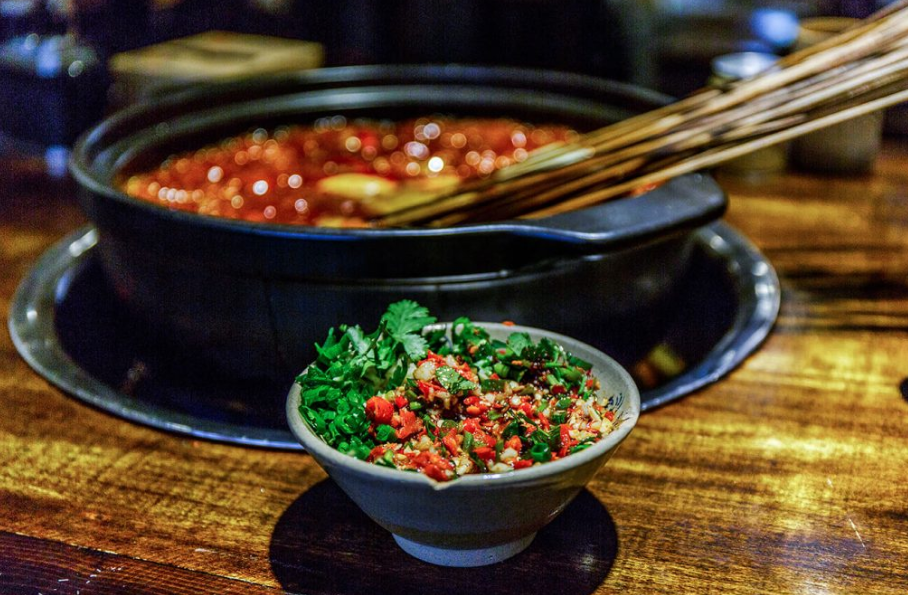
When it comes to Chongqing, there is a deliciousfood that has to be mentioned, that is “hot pot”. The spicy hot potoriginated from Chongqing Yangtze River shipping terminal is not only therepresentative of Chongqing cuisine, but also the perfect display of the unique temperament of the city.
Hundreds of special ingredients dance together inthe boiling hot pot, with meat and vegetable collocation, spicy and delicious,hearty and memorable. The city’s landscape culture and the human taste of marketplace are all integratedin a small pot. It is just like Chongqing people’s personality culture ofenthusiasm, boldness, tenacity, openness and inclusiveness. Tourists from allover the world gather in Chongqing to eat a hot pot, like a family; drinking anold wine makes friends all over the world. The different taste of Chongqingshows the world a new way of appreciating and interpreting Chinese culture,interpreting its meaning and enjoying its delicacy. Tourists from all over theworld can uncover the mystery of Chinese cuisine through hotpot and see thedifferent side of Chongqing.

Hot pot can be seen everywhere in Chongqing. There are only 10,000 taxis in Chongqing, but there are more than 20,000 hot potstores. You may not get a taxi on the street, but you can definitely eat hotpot. Chongqing is a city that is not afraid of spicy food. Our hot pot can be extremely spicy, medium spicy and mild spicy. You can enjoy Sichuan Opera, magic acrobatics and other characteristic cultural performances while eating hot pot, and slowly feel the temperature of this city.
7 Things that Will Make You Fall in Love with HotPot
“Five masters under heaven” is a common theme inChinese Martial Arts Fantasy Author Jin Yong’s novels. In Jin Yong’s universe, each of the five cardinal directions in ancient China (north, south, east, west,and center) are represented by an unparalleled master of a school of martialarts.
And so it is with Chongqing’s most distinctive and famous food – hot pot. Hotpot sprung out of the alleys and streets of dock side Chongqing and soon spread to all corners of China, creating a new legend in theuniverse of Chinese cuisine with its own “seven masters”: numb, spice,freshness, savory, presentation, flavor, and honor. Let’s take a closer look at these seven indispensable elements upon which every hotpot under heaven is judged.
Numbness
The numbness in Chongqing hotpot comes from the Sichuan Peppercorn, a type of unique seasoning that goes by many names, none of which are common in the west. Most westerners haven’t heard of this small, curious seed, but as soon as the tasteit, they will immediately feel a numbing, fresh flavor that defies description.

We can also find some oblique and mysterious references to the Sichuan Peppercorn in the annals of Chinese history. The ancient Book of Poems (shijing) states: “the seeds of the peppercorn tree flourishes – enough to fill many baskets” while The Ode to the West, written more than 2000 years ago, says that “in theharams of the emperor, the peppercorn trees flourished. The trees were meant to symbolize the birthof many sons lasting eternally into posterity.
The numbing peppers are grown throughout Chongqing and are a necessary ingredient to hotpot. Together with the hot peppers, the numbing flavor of the peppercornbrings out and magnifies the spice, creating an intense blend of intoxicating excitement in your mouth. The Chinese also believe that the numbness and spiciness combined can drive out the “cold” in the body that causes illnesses and protect it from pain.
Spice
Spice, of course, comes from spicy peppers. Peppers aren’t native to China but werebrought over in the 16th century from Central and South America, where theyoriginated. In the beginning, thepeppers were actually just ornamental and were used for viewing anddecoration. Not so in Chongqing, wherethe peppers were put into immediate use. By the high Qing (around 300 years ago), the peppers were recorded byliterati as being used in Sichuan hotpot (Chongqing was once part of Sichuan)as being “hot broth, numb and fresh with an intense flavor that never gets old”.
Freshness
Freshness, of course, comes from the preparation ofthe food itself, and determines its quality. In Chongqing hotpot, having fresh ingredients that go into the pot is animportant part of the overall quality of the flavor, and is highly regarded by Chongqing locals. This can be seen fromthe fact that the locals all know by heart the amount it takes to cook the foodthat goes in the steaming broth to the maximum amount of freshness without being overcooked. 8 seconds for tripe,12 seconds for duck intestines…you get the point!

Savory
“Savory”, “flavorful” or “aroma” is a word that is difficult to translate into English, but basically encompasses the flavor palate that is made of up the multitude of spices that go into hotpot. For example, douban (a paste mixture of hotspices), sannai, star anise, cinnamon, geranium, and so on. Picture a pot full of spicy broth, mixed withdozens of seasonings and spices, put on a fire, slow cooking (or fast cooking) your fresh duck intestines to perfection! The savory aroma from a hotpot place fills the streets and corners of Chongqing and is enough to get your mouth watering!
Presentation or appearance
The oil used in the spicy broth of Chongqing hotpotis made from beef fat, which adds a shiny, smooth and hearty texture to thebroth, combined with the pungent flavor of the spices and peppers, create anappearance that can be likened to smooth red satin, firing up the taste buds ofall who see it!
Flavor
The flavor here means not only the actual flavor of the hotpot but the “flavor” of hotpot and the daily lives of the people in Chongqing. There is a saying here:“there isn’t anything that can’t be solved over a hotpot, if not one, thentwo!” A steaming, bubbling cauldron ofspicy broth, surrounded by a couple of your best friends, in a soggy-coldwinter’s day Is enough to warm your heart and raise the spirits.
Code of honor
Chongqing hotpot came to being in the back-alleys of Chongqing and on the backs of the dockworkers and laborers who toiled, scrapingby to make a living. Owing to thesehumble roots, as well as the gangs and collectives that formed to help oneanother, hotpot isn’t only a meal, it’s a lifestyle It is ride or dies with thepeople who you depend on. Chongqing people say that “a person from Chongqing islike a hotpot; fiery, direct, in-your-face, fresh, strong, and honest.” It is someone that you should be able to depend on.
Hotpot isn’t the only hot pot, but a way of lifehere. The blood that runs through peoplein Chongqing is red – red like the fiery broth of the food they most love.
Xiao Mian Chongqing Noodles

People from other places may hear about ChongqingHot-pot, bridges, or mountains, but there is a dish which is more popular andcustomer-friendly —— Xiao Mian. It refers to Chongqing noddles, local fast foodmade with fresh herbs and spices. Most important of all, it can be made toorder, with unique spicy-numbly flavor that the locals love most.
The locals love Xiao Mian as much as they lovehot-pot and enjoy it in the morning, lunch, dinner or night. In the morning,many small, hole-in-the-wall street-side Xiao Mian restaurants are throngedwith people, who choose Xiao Mian to start the day. No matter who you are, anoffice worker on their way to work, or a “stick-stick” porter starting anotherhard day of work early birds often get their morning’s energy for working orstudying from spicy and delicious Xiao Mian. Xiao Mian is true “the people’s food”. For those Chongqing locals faraway from home, Xiao Mian is their “comfort food”, and they often choose XiaoMian as the first meal when they come back.
There are two types of Xiao Mian: noodles with brothand noodles without broth. A bowl of Xiao Mian usually uses more than 10 spices and condiments such as Sichuan pepper, chilies, spring onions, and etc. Otherwise, there are many different toppings can choose for Xiao Mian like beef, shredded chicken, or pork and so on. Thus, it is not only a dish but an art form in Chongqing.
After years’ development, there are many other typesas ramifications of Xiao Mian: Daoxiao Mian (noodles peeled from a dough directly into the pot), Pugai Mian (shape of noodle looks like blankets), etc. These ramifications usually use the same condiments and toppings as XiaoMian’s, but chew feeling is totally different from Xiao Mian. You can experience the real Chongqing life by getting some Xiao Mian.
Even though hotpot is Chongqing’s most famous food,recently a new rival has emerged: chuan chuan. Chuan chuan, meaning something like “skewered food” is a sort of remixof the classic hot pot theme. Unlike traditional hotpot, however, the ingredients of chuan chuan are skewered on sticksand then placed in the boiling oil within a clay or iron pot, making it moreconvenient to pick up the food after it is cooked in the pot.

Both hotpot and chuan chuan have their advantages. Some say that the flavor of chuan chuan is “too mild” for their taste, or like the old school feels of hotpot. Others like the ingredients orthe convenience of cooking food on kabobs. Whatever your preference, chuan chuan ranks up with hotpot as a must-tryin Chongqing.
The local in Chongqing come to that kind of ChuanChuan Restaurant from all districts to satisfy their taste buds but not for novelty or following. Variety of dishes and unique taste impress visitors and keep them coming back for more. Many restaurants locate downstairs of an oldresidential building or in the labyrinthine laneways, always thronged withcrowds inside and lines outside when visiting or just passing by every time.
Please follow us
Web:www.ccccph.org
Facebook: www.facebook.com/ccccph
Instagram: www.instagram.com/chinaculturalcentercph
Youtube:哥本哈根中国文化中心
Twitter: @ccc_copenhagen
TikTok: @ccc_copenhagen





